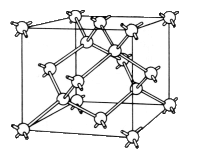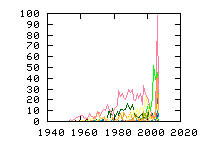« Previous
1
Next »
(22 hits, 1/1)
Showing
10, 25, 50, 100, 500, 1000, all papers per page.
Sort by:
last publication date,
older publication date,
last update date.
- 1. Phys. Rev. B 75, 075304 (2007) , “Damage evolution in low-energy ion implanted silicon”, R. Karmouch, Y. Anahory, J.-F. Mercure, D. Bouilly, M. Chicoine, G. Bentoumi, R. Leonelli, Y. Q. Wang, and F. SchiettekatteThe annealing of damage generated by low-energy ion implantation in polycrystalline silicon (poly-Si) and amorphous silicon (a-Si) is compared. The rate of heat release between implantation temperature and 350–500 °C for Si implanted in both materials and for different ions implanted in... (Read more)
- 2. Phys. Rev. B 75, 075201 (2007) , “Influence of isotopic substitution and He coimplantation on defect complexes and voids induced by H ions in silicon”, O. Moutanabbir, B. Terreault, M. Chicoine, F. Schiettekatte, and P. J. SimpsonWe present a detailed study of the comparative thermal evolutions of H- and D-related defects in silicon implanted with 2×1016 H or D/cm2, or coimplanted with 0.25×1016 He/cm2 and 0.7×1016 H/cm2, in both orders.... (Read more)
- 3. Phys. Rev. Lett. 98, 216103 (2007) , “Influence of Cumulenic Chains on the Vibrational and Electronic Properties of sp-sp2 Amorphous Carbon”, L. Ravagnan, P. Piseri, M. Bruzzi, S. Miglio, G. Bongiorno, A. Baserga, C. S. Casari, A. Li Bassi, C. Lenardi, Y. Yamaguchi, T. Wakabayashi, C. E. Bottani, and P. MilaniWe report the production and characterization of a form of amorphous carbon with sp-sp2 hybridization (atomic fraction of sp hybridized species 20%) where the predominant sp bonding appears to be (=C=C=)n cumulene.... (Read more)
- 4. Phys. Rev. Lett. 98, 095901 (2007) , “Experimental Evidence of the Vacancy-Mediated Silicon Self-Diffusion in Single-Crystalline Silicon”, Yasuo Shimizu, Masashi Uematsu, and Kohei M. ItohWe have determined silicon self-diffusivity at temperatures 735–875 °C based on the Raman shift of longitudinal optical phonon frequencies of diffusion annealed 28Si/30Si isotope superlattices. The activation enthalpy of 3.6 eV is obtained in such low temperature... (Read more)
- 5. Appl. Phys. Lett. 89, 241911 (2006) , “Defect and stress characterization of AlN films by Raman spectroscopy”, Vanni Lughi and David R. ClarkeRaman spectroscopy was used to characterize the residual stress and defect density of AlN thin films reactively sputtered on silicon (100). The authors studied the correlation between the shift of the E2 (high) phonon of AlN at 658 cm−1 and the film biaxial stress... (Read more)
- 6. Appl. Phys. Lett. 89, 131918 (2006) , “Hydrogen incorporation processes in nanodiamond films studied by isotopic induced modifications of Raman spectra”, Sh. Michaelson, O. Ternyak, A. Hoffman, and Y. LifshitzThe effect of replacing H by D and C-12 by C-13 in the gas species used to grow different types of nanodiamond films on the Raman spectra of these films was studied. The modifications of the Raman spectra were investigated in submicron sized diamond films grown by hot filament chemical vapor... (Read more)
- 7. J. Appl. Phys. 100, 073511 (2006) , “Depth profiling of strain and defects in Si/Si1–xGex/Si heterostructures by micro-Raman imaging”, T. Mitani, S. Nakashima, H. Okumura, and A. OguraWe have reported depth and in-plane profiling of strain, Ge composition, and defects in strained-Si/Si1–xGex/Si heterostructures using micro-Raman imaging. Raman profiling in the depth direction was carried out with a depth resolution of ~15 nm using a... (Read more)
- 8. J. Appl. Phys. 100, 034911 (2006) , “Thermal evolution of hydrogen related defects in hydrogen implanted Czochralski silicon investigated by Raman spectroscopy and atomic force microscopy”, W. Düngen, R. Job, Y. Ma, Y. L. Huang, T. Mueller, W. R. Fahrner, L. O. Keller, J. T. Horstmann, and H. FiedlerMicro-Raman spectroscopy and atomic force microscopy investigations have been applied on hydrogen implanted p-type Czochralski silicon samples to investigate the hydrogen related defects and their evolution after subsequent annealing. The thermal evolution of interstitial-hydrogen and... (Read more)
- 9. J. Appl. Phys. 99, 123515 (2006) , “Raman spectroscopy of (Mn, Co)-codoped ZnO films”, C. L. Du, Z. B. Gu, M. H. Lu, J. Wang, S. T. Zhang, J. Zhao, G. X. Cheng, H. Heng, and Y. F. ChenRaman spectra of (Mn, Co)-codoped ZnO films were investigated as functions of laser line and temperature. It is shown that the Raman shifts for different phonon modes exhibit redshift with temperature increasing, which can be attributed to the anharmonic effect in the material. Strong resonant Raman... (Read more)
- 10. J. Appl. Phys. 99, 113520 (2006) , “Effects of hydrogen bond redistribution on photoluminescence of a-SiC:H films under thermal treatment”, A. V. Vasin, S. P. Kolesnik, A. A. Konchits, V. I. Kushnirenko, V. S. Lysenko, A. N. Nazarov, A. V. Rusavsky, and S. AshokHydrogenated amorphous silicon carbide (a-SiC:H) films have been deposited using magnetron sputtering technique. An integrated investigation of the effect of vacuum annealing temperature on photoluminescence properties and paramagnetic defects and its correlation with structural... (Read more)
- 11. J. Appl. Phys. 99, 103905 (2006) , “Effect of Mn+ ion implantation on the Raman spectra of ZnO”, Hongmei Zhong, Jinbing Wang, Xiaoshuang Chen, Zhifeng Li, Wenlan Xu, and Wei LuRaman measurements have been performed on ZnO bulk materials implanted with 220 keV Mn+ ions with various doses from 1015 to 1017 cm2. The results reveal two modes at about 230 and 523 cm–1, respectively, which are not observed in... (Read more)
- 12. Phys. Rev. B 74, 235214 (2006) , “Raman scattering study of H2 in Si”, M. Hiller, E. V. Lavrov, and J. WeberIsolated interstitial H2 and H2 bound to interstitial oxygen (O–H2) in single-crystalline Si are studied by Raman scattering. Two Raman signals at 3199(1) and 3193(1) cm−1 (T0 K) are identified as ro-vibrational transitions of... (Read more)
- 13. Phys. Rev. B 74, 195101 (2006) , “Characterization of the hyperfine interaction in europium-doped yttrium orthosilicate and europium chloride hexahydrate”, J. J. Longdell, A. L. Alexander, and M. J. SellarsWe present characterization of the hyperfine interaction for the europium in hydrated europium chloride and as a dopant in yttrium orthosilicate. The Zeeman and pseudoquadrupole tensors were determined by measuring the hyperfine splittings while rotating the direction of a weak (~300 G) magnetic... (Read more)
- 14. Phys. Rev. B 74, 155208 (2006) , “Vibrational spectra of vitreous germania from first-principles”, Luigi Giacomazzi, P. Umari, and Alfredo PasquarelloWe report on a first-principles investigation of the structural and vibrational properties of vitreous germania (v-GeO2). Our work focuses on a periodic model structure of 168 atoms, but three smaller models are also studied for comparison. We first carry out a detailed structural... (Read more)
- 15. Physica B 376-377, 486 (2006) , “Preferential substitution of Fe on physically equivalent Ga sites in GaN”, W. Gehlhoff, D. Azamat, U. Haboeck, A. HoffmannThe EPR spectra of Fe3+ in high-quality thick freestanding hydride vapor phase grown GaN have been studied in the X- and Q-band. A complex resonance pattern with numerous lines of different intensities provided by three different defects is observed for these nearly stress-free iron-doped samples.... (Read more)
- 16. Chem. Phys. Lett. 415, 337 (2005) , “No ferromagnetism in Mn doped ZnO semiconductors”, J. Alaria, P. Turek, M. Bernard, M. Bouloudenine, A. Berbadj, N. Brihi, G. Schmerber, S. Colis , A. DiniaPolycrystalline Zn1 − xMnxO was synthesized by co-precipitation method with xvarying between 0.01 and 0.10. Although X-ray diffraction patterns show a typical würtzite structure with no additional peaks for all samples, Raman spectroscopy indicates the appearance of an additional mode in... (Read more)
- 17. J. Cryst. Growth 264, 1-6 (2004) , “Ammonolysis of Ga2O3 and its application to the sublimation source for the growth of GaN film”, Y. J. Park , C. S. Oh , T. H. Yeom, Y. M. YuWe have observed the nagnetic resonance of conduction electrons in n-type indium antimonide, by the "heating" of the electron kinetic-energy temperature via the slsctron spins. This is the first direct evidence suggesting a contribution of spin-orbit coupling to relaxation in this system. In a steady-state spin-resonance experiment, a power PS=(M0=MZ)H/T1 is transferred to the systems(reservoirs) towards which the spins relax. Here, M0 is the equilibrium magnetization, MZ the component of the magnetization along the magnetic field H, and T1 the relaxation time. The reservoir of interest in our case is the kinetic energy of the eledtrons, and this is detected by an increase in the mobility μ. To our knowledge. this is the first observation of the power flow, due to relaxation, from the spins to a reservoir,applied to the ditection of magnetic resonance of conduction-electron spins. It differs in principle from usual spin-resonance observation methods, which are based on electromagnetic interactions of the spin system, such as the voltage induced in a resonator by the rotating magnetic moment, or again such as power absorption PS=MyHx from the rotating field Hx by the out-of- phase component My.Besides providing information on the relaxation mechanism, the present method (that we call "ralaxation" method) should also in some cases by much more sensitive than the usual "electromagnetic" detection methods. (Read more)
- 18. phys. stat. sol. (c) 1, 3110 (2004) , Wiley InterScience , “Raman spectra of lead chalcogenide single crystals”, S.V. Ovsyannikov, Y.S. Ponosov, V.V. Shchennikov, V.E. MogilenskikhRaman spectra of single crystals of lead chalcogenides (PbTe, PbSe, PbS) were studied at room temperature and ambient pressure. The structure of spectra for all compounds is rather similar showing the bands in one- and two-phonon range. Possible spectra identification is discussed. (© 2004... (Read more)
- 19. Mater. Sci. Eng. A 332, 356-361 (2002) , “The preparation and characterization of ZnO ultrafine particles”, Liqiang Jing, Zili Xu, Jing Shang, Xiaojun Sun, Weimin Cai and Haichen GuoIn this paper, ZnO ultrafine particles (UFPs) were prepared by the thermal decomposition method of the precursor, zinc carbonate hydroxide. The structure and properties of the as-prepared ZnO UFPs were studied using TEM, XRD, BET, SPS, ESR, Raman, XPS and UV–Vis absorption spectroscopy. It... (Read more)
- 20. Nucl. Instrum. Methods Phys. Res. B 141, 566-574 (1998) , “Defect formation in amorphous SiO2 by ion implantation: Electronic excitation effects and chemical effects”, H. Hosono, N. MatsunamiIntrinsic defect formation in amorphous (a-) SiO2 by ion implantation was examined with emphasis upon electronic excitation effects and chemical reaction effects. 10 MeV proton beam and boron beam irradiated silica platelets to examine electronic excitation effects and chemical reaction effects. In... (Read more)
- 21. Phys. Rev. Lett. 80, 317-320 (1998) , “Experimental Evidence for Frenkel Defect Formation in Amorphous SiO2 by Electronic Excitation”, H. Hosono, H. Kawazoe, N. MatsunamiConcentrations of defects in amorphous SiO2 created by implantation of 10 MeV protons were examined. The depth profile of Si-Si bonds, E? centers, or peroxy radicals (PORs) was close to that of electronic energy loss. Interstitial O2 molecules were identified and... (Read more)
- 22. Phys. Rev. B 7, 4547 (1973) , “Raman Scattering and Photoluminescence in Boron-Doped and Arsenic-Doped Silicon”, J. M. Cherlow, R. L. Aggarwal, and B. LaxThe deformation potentials and g values of the ground state of the boron acceptor in silicon have been determined from a study of the stress and Zeeman splitting of the electronic Raman scattering in this material. The stress splitting of the Raman line results from a twofold splitting of the... (Read more)
« Previous
1
Next »
(22 hits, 1/1)
Showing
10, 25, 50, 100, 500, 1000, all papers per page.
Sort by:
last publication date,
older publication date,
last update date.
All papers (3399)
Updated at 2010-07-20 16:50:39
Updated at 2010-07-20 16:50:39
(view as: tree
,
cloud
)
| 1329 | untagged |
Materials
(111 tags)
Others(101 tags)
Technique
(46 tags)
Details
(591 tags)
Bond(35 tags)
Defect(interstitial)(18 tags)
Defect(vacancy)(15 tags)
Defect-type(19 tags)
Element(65 tags)
Energy(8 tags)
Isotope(56 tags)
Label(303 tags)
Sample(17 tags)
Spin(8 tags)
Symmetry(15 tags)

